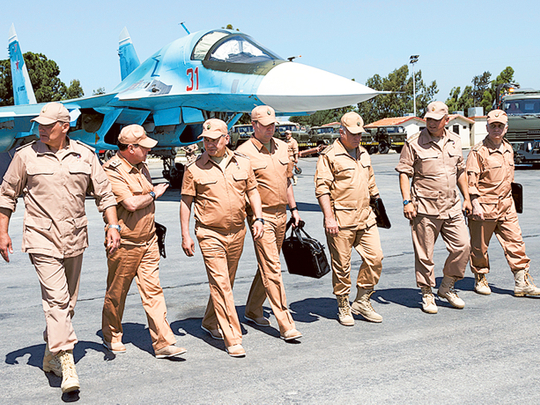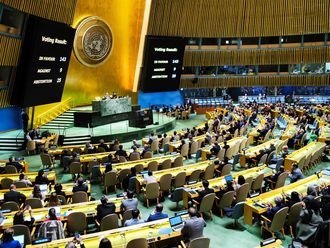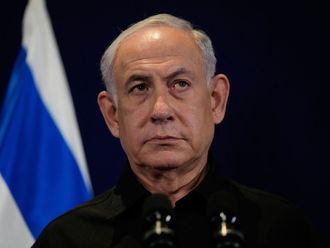
Washington: Russia and the United States have agreed on the need to improve coordination to avert incidents while conducting military operations in Syria, the Russian defence ministry said on Sunday.
Military officials from the two countries reached the agreement at a video conference, the ministry said.
On Saturday, senior US and Russian defence officials held what the Pentagon described as an “extraordinary” videoconference to discuss Russian air strikes that days earlier hit a garrison manned by Syrian rebels backed by the United States.
The Russian strikes hit Syrian opposition fighters on Thursday at Al Tanf crossing, which lies on Syria’s border with Iraq. The rebels there are battling Daesh, the Pentagon said, and are also supposed to be covered by a partial ceasefire that the United States and Russia brokered in February.
During the videoconference, Pentagon officials “expressed strong concerns about the attack” on forces that are fighting Daesh, Peter Cook, Defence Department spokesman, said in a statement.
US officials told the Russians that their strikes had continued even after they were officially informed that allied air support was under way for the rebels and that this had “created safety concerns for US and coalition forces”, the statement said.
Although fighting has tapered off in many areas since the ceasefire went into effect in February, there have been fierce clashes in recent weeks in areas of northern Syria where Daesh and Al Nusra Front are strongest. US officials have accused Russia of failing to stop the forces of Syria’s President, Bashar Al Assad, from violating the ceasefire and attacking rebel groups backed by the United States.
There was no immediate word on how Russian officials responded to the concerns expressed by US officials on Saturday. But the videoconference took place as Russia’s defence minister, Sergei Shoigu, met with Al Assad in Damascus and visited the Russian airbase in Syria, The Associated Press reported.
Since the Russian air campaign in Syria began in September, it has helped Al Assad’s forces reclaim territory, reversing the fortunes of a regime that at this time last year appeared to be in an increasingly perilous position.
US-backed rebel forces, in contrast, have continued to struggle on the battlefield against both Al Assad’s forces and Daesh, and more than 50 State Department diplomats recently signed an internal memo sharply critical of the Obama administration’s policy in Syria.
On Thursday, Russian warplanes hit Pentagon-backed Syrian fighters with a barrage of air strikes earlier this week, disregarding several warnings from US commanders in what American military officials called the most provocative act since Moscow’s air campaign in Syria began last year.
The strikes hit a base near the Jordanian border, far from areas where the Russians were previously active, and targeted US-backed forces battling the Daesh militants.
No US forces were present in the area, but the US military scrambled fighter jets and used an emergency communications channel set up to avoid air accidents to tell Russian officers to end the strikes, according to the officials, who spoke on Friday about the incident after requesting anonymity because they were not authorised to discuss the matter publicly.
The Russian Su-34 fighter-bombers left the area at first, but came back for a second strike after the US F/A-18 fighters went to refuel. The second attack killed several Syrian rebels attempting to provide medical support to the survivors of the initial one, officials said.
“It’s an egregious act that must be explained,” a US official said. “The Russian government either doesn’t have control of its own forces or it was a deliberate provocative act. Either way, we’re looking for answers.”
The incident came amid calls within the US government for a tougher approach to the Syrian conflict.
On Thursday, an internal State Department memo became public in which 51 diplomats, using the State Department’s long-standing dissent process, criticised President Obama’s policy and called for US military strikes against forces loyal to Syrian President Bashar Al Assad, Russia’s ally.
State Department spokesman John Kirby on Friday conceded that such a large number of signatures on a dissent memo was “unusual”.
“No one’s content with the status quo,” he said. “Too many people are dying.”
Al Assad’s army continues to bomb civilian neighbourhoods as the bloody civil war plods toward its fifth year.
US officials believe the strikes were launched to pressure the US into working with Russia. Moscow has long wanted the US to combine its air campaign in Syria with Moscow’s so they can share intelligence and targeting information.
The Obama administration has rejected that idea because it would put US forces on the same side as Al Assad. The administration says Al Assad must leave power, although officials have said he could remain for a period of “managed transition”.
The Russian strike hit a small rebel base for staging forces and equipment in a desolate, unpopulated area near the border. About 180 rebels were there as part of the Pentagon’s programme to train and equip fighters against Daesh.
When the first strikes hit, the rebels called a US command centre in Qatar, where the Pentagon orchestrates the daily air war against Daesh.
US military commanders called their Russian counterparts on a special hotline set up to ensure the two countries’ pilots will not mistakenly run into — or fire upon — one another as they conduct daily bombing runs in the skies above Syria.
Two Navy fighter jets were scrambled from one of two US aircraft carriers stationed in the Mediterranean Sea. The US pilots visually identified the pair of Russian jets, which briefly left the area but returned once the American planes went for additional fuel.
US Defence Secretary Ashton Carter briefly addressed the incident with reporters at the Pentagon, saying the US military was attempting to “clarify the facts” on why the communications channel wasn’t “professionally” utilised.
Pentagon officials have said in the past that the US military would defend forces it trained if they were threatened inside Syria by Al Assad’s government.
“This was an attack on forces, first of all, that were fighting Daesh,” Carter said. “Obviously that’s the first thing that’s problematic about this Russian conduct.”
Kremlin spokesman Dmitry Peskov appeared to confirm the attack on Friday, telling reporters it was difficult to distinguish different rebel groups from the air.
Russian President Vladimir Putin has repeatedly said Moscow’s air campaign is aimed at Daesh. But the strikes, instead, have focused on moderate opposition forces and to some extent on Al Nusra Front, a group aligned with Al Qaida, according to analyses by US intelligence officials. The Russian military has launched a relatively small number of air strikes against Daesh, mostly for propaganda purposes, US officials say.
Putin has called for a broad international coalition to fight Daesh, including the United States and other Western countries already waging air strikes on the militants. He has insisted, however, that Al Assad be involved in the campaign and that any foreign interventions be subject to the approval of the Syrian leader, whom he has described as a bulwark against terrorism.
“It’s about ensuring Al Assad’s hold on power and weakening his enemies,” said Dmitry Gorenburg, a senior research scientist on Russia at CNA, a think tank based in Arlington, Virginia. The Russians feel that “having accomplished a great deal in the north, there’s no reason not to do something similar in the south,” he said.












